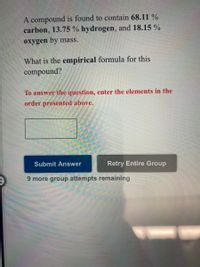
Chemistry
10th Edition
ISBN: 9781305957404
Author: Steven S. Zumdahl, Susan A. Zumdahl, Donald J. DeCoste
Publisher: Cengage Learning
expand_more
expand_more
format_list_bulleted
Concept explainers
Question

Transcribed Image Text:A compound is found to contain 68.11 %
carbon, 13.75 % hydrogen, and 18.15 %
oxygen by mass.
What is the empirical formula for this
compound?
To answer the question, enter the elements in the
order presented above.
Submit Answer
Retry Entire Group
9 more group attempts remaining
Expert Solution
This question has been solved!
Explore an expertly crafted, step-by-step solution for a thorough understanding of key concepts.
This is a popular solution
Trending nowThis is a popular solution!
Step by stepSolved in 2 steps with 2 images

Knowledge Booster
Learn more about
Need a deep-dive on the concept behind this application? Look no further. Learn more about this topic, chemistry and related others by exploring similar questions and additional content below.Similar questions
- This is the chemical formula for diethyl ether: (CH,CH,),O. Calculate the mass percent of carbon in diethyl ether. Round your answer to the nearest percentage. Xarrow_forwardUse the References to access important values if needed for this question. Calculate the percentage composition for N2F4. Mass percentage of nitrogen = | % Mass percentage of fluorine = | Submit Answer Retry Entire Group 8 more group attempts remainingarrow_forwardQuestion 33.arrow_forward
- Without doing any calculations, determine the sample will contains the greatest amount of the element in moles. Which contains the greatest mass of the element? 45.0 g Tiarrow_forwardA compound is found to contain 30.45 % nitrogen and 69.55 % oxygen by mass. What is the empirical formula for this compound? To answer the question, enter the elements in the order presented above. Submit Answerarrow_forwardFÖRMULA/MOLECULAR WEIGHT Calculate the formula weight of the following compounds. 17) For ionic compounds, the formula weight is called the formula unit. a) NaCl b) LiBr c) MgCl, d) Ca(NO,),arrow_forward
- A compound is found to contain 37.32 % phosphorus, 16.88 % nitrogen, and 45.79 % fluorine by mass. What is the empirical formula for this compound? To answer the question, enter the elements in the order presented above.arrow_forwardA sample contains 1.3 moles of carbon ,1.3 moles of hydrogen and 6.5 moles of oxygen. Find the empirical formula. What is the subscript for oxygenarrow_forwardA compound containing carbon hydrogen chlorine and oxygen has the following mass compositions 38.37% of carbon 1.49% hydrogen and 52.28% chlorine. Write down the exact series of steps you need to do to figure out the empirical formula for this compoundarrow_forward
- From the given molar mass and empirical formula of several compounds, find the molecular formula of each compound. C4H9 , 114.18 g/mol CCl , 284.77 g/mol C3H2N , 260.35 g/mol Please provide only typed answer solution no handwritten solution needed allowedarrow_forward1) Hypothetical Data for AnalysisAn oxide of iron is 69.94% iron by mass. Calculate its empirical formula and determine the name of the ionic compound. (Hint: assume you have a 100 g sample of the oxide of iron. How many grams would be iron? Then how many grams would be oxygen? Convert those to moles. Find the ratio. Find the nearest whole number ratio). Then determine its namearrow_forwardA compound is found to contain 11.21 % hydrogen and 88.79 % oxygen by mass. What is the empirical formula for this compound? To answer the question, enter the elements in the order presented above. Submit Answer Retry Entire Group 9 more group attempts remainingarrow_forward
arrow_back_ios
SEE MORE QUESTIONS
arrow_forward_ios
Recommended textbooks for you
 ChemistryChemistryISBN:9781305957404Author:Steven S. Zumdahl, Susan A. Zumdahl, Donald J. DeCostePublisher:Cengage Learning
ChemistryChemistryISBN:9781305957404Author:Steven S. Zumdahl, Susan A. Zumdahl, Donald J. DeCostePublisher:Cengage Learning ChemistryChemistryISBN:9781259911156Author:Raymond Chang Dr., Jason Overby ProfessorPublisher:McGraw-Hill Education
ChemistryChemistryISBN:9781259911156Author:Raymond Chang Dr., Jason Overby ProfessorPublisher:McGraw-Hill Education Principles of Instrumental AnalysisChemistryISBN:9781305577213Author:Douglas A. Skoog, F. James Holler, Stanley R. CrouchPublisher:Cengage Learning
Principles of Instrumental AnalysisChemistryISBN:9781305577213Author:Douglas A. Skoog, F. James Holler, Stanley R. CrouchPublisher:Cengage Learning Organic ChemistryChemistryISBN:9780078021558Author:Janice Gorzynski Smith Dr.Publisher:McGraw-Hill Education
Organic ChemistryChemistryISBN:9780078021558Author:Janice Gorzynski Smith Dr.Publisher:McGraw-Hill Education Chemistry: Principles and ReactionsChemistryISBN:9781305079373Author:William L. Masterton, Cecile N. HurleyPublisher:Cengage Learning
Chemistry: Principles and ReactionsChemistryISBN:9781305079373Author:William L. Masterton, Cecile N. HurleyPublisher:Cengage Learning Elementary Principles of Chemical Processes, Bind...ChemistryISBN:9781118431221Author:Richard M. Felder, Ronald W. Rousseau, Lisa G. BullardPublisher:WILEY
Elementary Principles of Chemical Processes, Bind...ChemistryISBN:9781118431221Author:Richard M. Felder, Ronald W. Rousseau, Lisa G. BullardPublisher:WILEY

Chemistry
Chemistry
ISBN:9781305957404
Author:Steven S. Zumdahl, Susan A. Zumdahl, Donald J. DeCoste
Publisher:Cengage Learning

Chemistry
Chemistry
ISBN:9781259911156
Author:Raymond Chang Dr., Jason Overby Professor
Publisher:McGraw-Hill Education

Principles of Instrumental Analysis
Chemistry
ISBN:9781305577213
Author:Douglas A. Skoog, F. James Holler, Stanley R. Crouch
Publisher:Cengage Learning

Organic Chemistry
Chemistry
ISBN:9780078021558
Author:Janice Gorzynski Smith Dr.
Publisher:McGraw-Hill Education

Chemistry: Principles and Reactions
Chemistry
ISBN:9781305079373
Author:William L. Masterton, Cecile N. Hurley
Publisher:Cengage Learning

Elementary Principles of Chemical Processes, Bind...
Chemistry
ISBN:9781118431221
Author:Richard M. Felder, Ronald W. Rousseau, Lisa G. Bullard
Publisher:WILEY